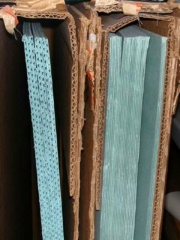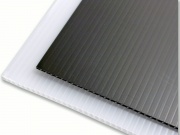Corrugated board
Description
A board that is folded or shaped with parallel alternative ridges and grooves. Corrugated or pleated Paper was patented in 1856 and in 1871 a patent was issued for corrugated Cardboard. By 1874, a machine was patented to make cellulosic corrugated board with liner sheets on each side. The alternating ridges increase the strength, and thickness of a material without increasing its weight. It is used for packaging and cushioning. Types of paper-based corrugated boards, such as Blueboard or Archival corrugated board, are often used in museums. More recently corrugated plastic sheets have also found multiple uses in museums. Some examples are: Coroplast, Cor-X, Correx, Hexlite, Hi-Core, Corrulite, Corulite, and Diversi-Plast.
Synonyms and Related Terms
Cellulosic: blueboard; corrugated paper; pleated paper; corrugated brown; cardboard
Plastic: fluted plastic sheet; polyflute
Resources and Citations
- Jean Tétreault, 'Products Used in Preventive Conservation – Technical Bulletin 32' CCI website
- Boise Cascade Paper Group, The Paper Handbook, Boise Cascade, Portland OR, 1989
- The Dictionary of Paper, American Paper Institute, New York, Fourth Edition, 1980
- E.J.LaBarre, Dictionary and Encyclopedia of Paper and Paper-making, Swets & Zeitlinger, Amsterdam, 1969 Comment: 1890 patented by G.M.Smith
- Wikipedia: http://en.wikipedia.org/wiki/Corrugated_board - gives the following patent dates: corrugated paper=1856 (England); corrugated cardboard=1871 (Albert Jones, U.S.); corrugated cardboard box=1890 (Robert Gair, U.S.)
- Book and Paper Group, Paper Conservation Catalog, AIC, 1984, 1989
- Art and Architecture Thesaurus Online, http://www.getty.edu/research/tools/vocabulary/aat/, J. Paul Getty Trust, Los Angeles, 2000

